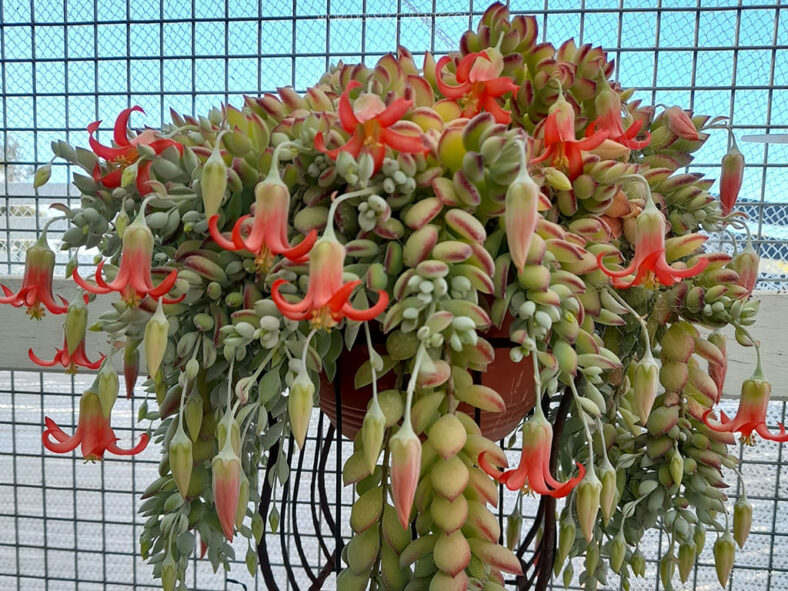Cotyledon is a genus of ten species of perennial shrubby succulents with numerous varieties and cultivars. Mostly from Southern Africa, they also occur throughout the drier parts of Africa as far north as the Arabian peninsula. Cotyledon has been a catch-all genus, including species from Echeveria, Rosularia, Tylecodon, and Umbilicus, which are now all grouped separately. Tölken (1978) separated 47 species of Tylecodon with seasonal, spirally arranged leaves from Cotyledon with perennial leaves. The name Tylecodon is an anagram of Cotyledon.
The genus members are generally succulent shrublets with fleshily woody, brittle stems and persistent fleshy leaves. The leaves are opposite. Leaf pairs are typically oriented at 90 degrees to their preceding and following pairs, as is common in the family Crassulaceae, but the leaf habit differs. They are varied in appearance, but all have tubular flowers with curled tips typically colored orange or coral pink. They bloom mostly in summer.
Cotyledons generally colonize rocky ground and cliff faces, a clue that they appreciate well-drained conditions in cultivation. The fleshy leaves of some species (Cotyledon ladismithiensis) are slightly pubescent or farinose (Cotyledon orbiculata).
These plants should be considered poisonous, as they are closely related to Tylecodons.

Growing Conditions and General Care
Cotyledons can be divided into two groups. One group consists of evergreen plants with a summer growing period. The other group comprises deciduous plants, splendidly magnificent with large, solid, fleshy stems. The second group grows during the winter and sheds its leaves during the summer.
Cotyledons require a free-draining soil mix and plenty of sunlight. If kept dry, they tolerate cool, frost-free conditions during the winter. Some require pruning to maintain an attractive shape.
Cotyledons should be kept in a sunny position. Follow general succulent watering procedures. Be careful of overwatering when Cotyledons are deciduous.
As succulents go, Cotyledons certainly are rewarding garden and indoor subjects, practically independent of irrigation in all but full desert conditions. However, they cannot survive poor light or bad drainage.
Feed them once or twice during the growing season with a fertilizer specifically formulated for succulents (poor in nitrogen), including all micronutrients and trace elements diluted to ½ the strength recommended on the label.
Though not spectacular, Cotyledons are elegantly decorative and often interesting in shape. In addition, the inflorescences of the larger species often make fine components of dried arrangements in floral design.
Pests and Problems
Their main enemies are sucking bugs.
Links
- Back to genus Cotyledon
- Succupedia: Browse succulents by Scientific Name, Common Name, Genus, Family, USDA Hardiness Zone, Origin, or cacti by Genus